the trees have grown to cover so much of the mural, but if you are in the neighborhood, stop by and take a look.
the trees have grown to cover so much of the mural, but if you are in the neighborhood, stop by and take a look.
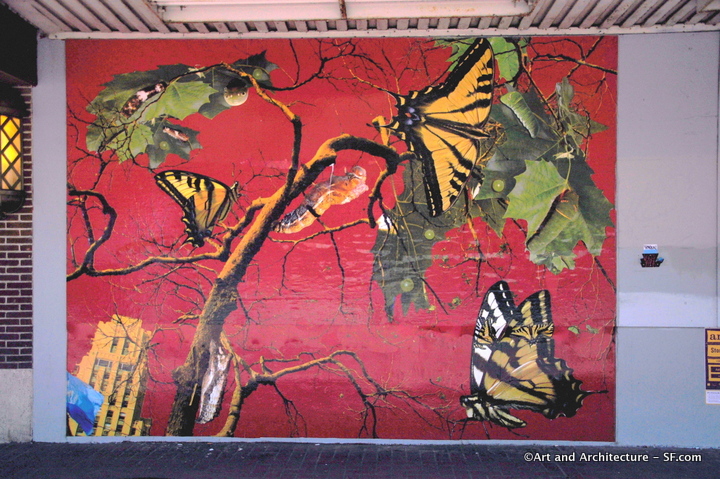 Mid Market area has long had a reputation for being a wasteland. Storefronts boarded up, tourists as well as locals, finding a way around this section of Market, without actually walking down it, a veritable waste land in the middle of a vibrant city.
Mid Market area has long had a reputation for being a wasteland. Storefronts boarded up, tourists as well as locals, finding a way around this section of Market, without actually walking down it, a veritable waste land in the middle of a vibrant city.
For years politicians, concerned citizens and property owners have tried to figure a way to revitalize the area. The artists have decided to use the area as a canvas and wait for the rest of the world to catch up.
The SF Arts Commission, for a few years now has been sponsoring Art in Storefronts around town, and the mid market area is an area they work hard to spotlight. Most of the art is, in fact, in storefronts, making it almost impossible to photograph. The windows are often barred, or the glare just makes for reflection and no way for me to bring you the actual art. However, some of the pieces are outside windows and a tad more accessible.
The above piece is about the metamorphosis of the western tiger swallowtail butterfly and its relationship to the sycamore trees planted along Market Street.
According to Amber’s website: The London plane is in the sycamore family, a hybrid between the oriental plane (Platanus orientalis) and the American sycamore (Platanus occidentalis). Today, as a result of the presence of this street tree, the western tiger swallowtail butterfly (Papilio rutulus) can be seen flying along Market Street. In early spring and late summer, western tiger swallowtail females fly among the corridor of sycamore trees, chemically sensing the larval food plant and laying eggs. The males fly low to mud puddles, where they extract salts to use for making sperm.
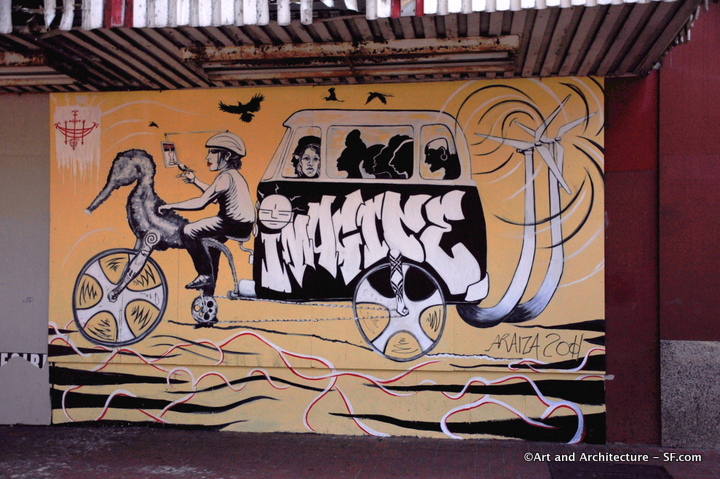 This mural, entitled Imagine by Juana Alicia Araiza was right next to Swallows and Sycamores. Araiza is a talented artist and teacher at Berkeley City College.
This mural, entitled Imagine by Juana Alicia Araiza was right next to Swallows and Sycamores. Araiza is a talented artist and teacher at Berkeley City College.
UPDATE – These murals are no longer available – 6/2012
United Nations Plaza is an area off of Market Street with a walkable corridor straight to Civic Center, which includes City Hall and Herbst Theatre. The United Nations Charter was signed in the War Memorial Veterans Building’s Herbst Theatre in 1945, leading to the creation of the United Nations.
According to Wikipedia “Civic Center has a seedy, run-down, high crime reputation and appearance with large amounts of Homeless encampments which has prevented it from attracting the large amounts of tourists seen in other areas of the city. Despite repeated redevelopment of Civic Center over the years aimed primarily at discouraging the homeless from camping there, large amounts of homeless continue to camp and loiter in the area.” Sadly, this is true.
The architecture of the Plaza itself is really beautiful. It was designed by world famous Lawrence Halprin in the 1970s. It is lined with granite columns engraved with a particular year and the countries that were inducted into the U.N. during that year. On the walkway are engraved sayings promoting peace over war, and there is of course, the ubiquitous water feature.
Sadly, none of this beauty has kept the less fortunate from making it a play ground and scaring others away.
This is directly from her blog – “Humming With Life”, the title of this mural is an understatement. The Post Office building at the corner of Hyde and Golden Gate is a magnet for drug dealers, crack addicts and homeless folks looking for a spot to lie down. The Tenderloin has long been the neighborhood that offers services to the down and out so this is where they live with the vibrant mix of cultures and community in the North of Market of downtown San Francisco. The Civic Center Post Office does not sell stamps or send mail. It has endless rows of post office boxes for people without permanent addresses.”
She has truly added a bright spot in a rather sorry part of town.
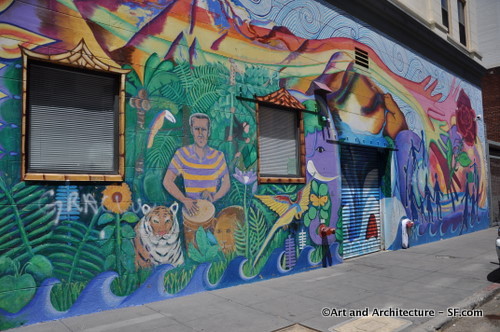 6th Street in San Francisco is not the nicest street in the city. Its overabundance of SRO’s crack dealers, and soup kitchens make it a street many people avoid. I took all these shots while wandering by myself, however, it was broad daylight. The point is, like any city, know your surroundings and keep your eyes open, and life is not all that scary.
6th Street in San Francisco is not the nicest street in the city. Its overabundance of SRO’s crack dealers, and soup kitchens make it a street many people avoid. I took all these shots while wandering by myself, however, it was broad daylight. The point is, like any city, know your surroundings and keep your eyes open, and life is not all that scary.
This mural was painted in 1998 by Precita Eyes. The designer and painter, specifically was William Boler Jr.
 This mural is on Gordon Street, South of Market. Gordon is a dingy dead end alley off of Harrison Streets between 8th and 9th. It is hard to find, and you would have no reason to even be on the alley, but it was a quiet Sunday and no cars or buses were blocking the view which is how I spied it. The mural is titled Zen and is by Kristine Brandt. Kristine studied at the Academy of Art University and the Florence Academy of Art. What I really loved is the incorporation of the mural right onto the sidewalk.
This mural is on Gordon Street, South of Market. Gordon is a dingy dead end alley off of Harrison Streets between 8th and 9th. It is hard to find, and you would have no reason to even be on the alley, but it was a quiet Sunday and no cars or buses were blocking the view which is how I spied it. The mural is titled Zen and is by Kristine Brandt. Kristine studied at the Academy of Art University and the Florence Academy of Art. What I really loved is the incorporation of the mural right onto the sidewalk.
This mural is right next to the one above. It is by Katya Kahn (2011)
 Katya Kahn has always sought to engage her community creatively, whether through designing, teaching, or mural painting. In her mural projects especially, Katya values the input of others to ensure the creation of a piece that resonates with the public. Katya has painted significant murals in San Francisco, San Diego, and Russia.
Katya Kahn has always sought to engage her community creatively, whether through designing, teaching, or mural painting. In her mural projects especially, Katya values the input of others to ensure the creation of a piece that resonates with the public. Katya has painted significant murals in San Francisco, San Diego, and Russia.
Both of these murals were partially funded by the SFAC StreetSmarts program.
This sign is an anathema to me for several reasons. While hard to read, it states that this building will be demolished and a 9 story building will be put up in its place. Although not highly ornamented, it does have some lovely features. When I see old buildings with history like this arbitrarily being tossed by the wayside so that a non-descript highrise can be built, it makes my blood boil.
 This fascinating piece is on the back side of Show Dogs Hot Dog Stand at the corners of 6th Street, Taylor and Market.
This fascinating piece is on the back side of Show Dogs Hot Dog Stand at the corners of 6th Street, Taylor and Market.
The mural is an homage to those movie and performance art theaters (Strand, Unique, Embassy, Rialto, Granada, Regal, Imperia, Pantages, Tivoli, Hub, State, Egyptian, etc) that once graced this area of Market Street prior to the 1906 earthquake and up into the 1950’s. It is part of the S.F. Arts Commission 2011 Art in Store Fronts Project.
The artist is Rafael Landea an Argentinean artist who moved to San Francisco in 2002. He earned his MFA in Painting and Set Design from the University of La Plata, Buenos Aires, Argentina. Obviously his passion for set design and theater was the impetus for this mural.
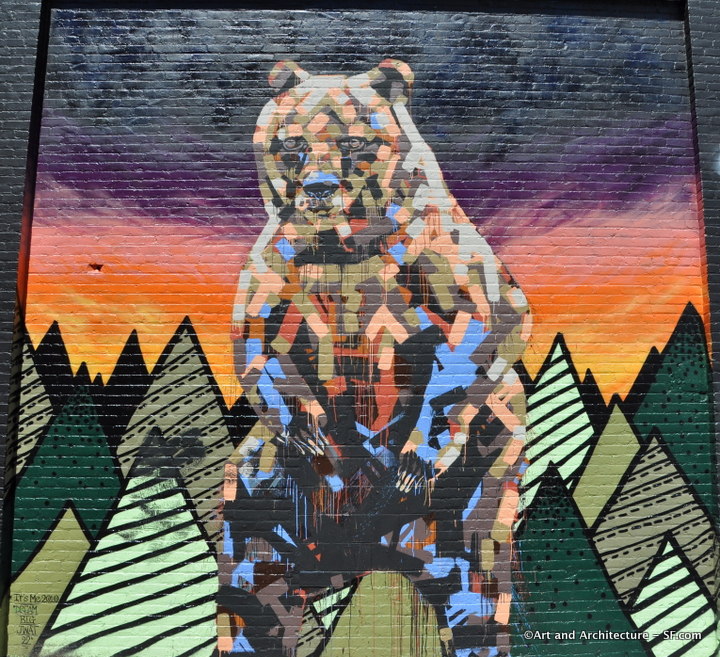 A while back I was walking in my own neighborhood, SOMA, (this is Berwick and Heron off of Harrison or 8th Streets) and in this little alley I came across this great big bear.
A while back I was walking in my own neighborhood, SOMA, (this is Berwick and Heron off of Harrison or 8th Streets) and in this little alley I came across this great big bear.
Well as I was wandering The Tenderloin Forest, I came across this guy
I knew I had seen this work before and was happy to see another wonderful character. Then last week I was driving through the intersection of Market and 6th Street and what do I see?
The artist is Chad Hasegawa. He was born in Hawaii and has quite a repertoire. This excerpt is from an interview he did with Blackbook Art Magazine.
“Grizzly bears are just something I enjoy painting and I really enjoy painting them big. They represent an outsider coming into a tamed city of walls all the way from nature. They represent the West and a lot of other things, especially in San Francisco. The way I see it, they came here first. And they probably came here for the same reasons we came here. San Francisco is an amazing place and in this 7×7 mile radius there is a lot going on here with the weather, the hills, the water, and the fog. I mean, there were 10,000 grizzly bears that used to live here and were forced to get along and agree with one another and stand together, and they were so stoked to be here that they had to be sucka free and didn’t mind living so close together. Or there were some bears that just didn’t get it and were forced to leave or left here on their own, just like us. ”
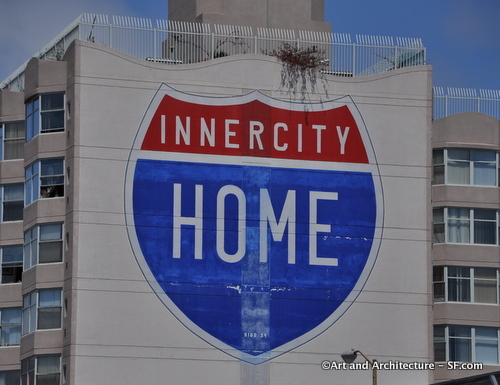 This is by Ricardo Gouveia, a Portuguese artist residing in San Francisco. From 1984-2002, Rigo used the last two digits of the current year as part of his name (in this case Rigo94) , finally settling upon “23″ in 2003. As part of TODCO’s Inner City Arts Program, Rigo worked with Sixth Street hotel tenants to create this powerful statement of community identity, painted on the Knox SRO and visible for miles. TODCO Group is a community-based housing/community development nonprofit corporation for San Francisco’s South of Market Neighborhood.
This is by Ricardo Gouveia, a Portuguese artist residing in San Francisco. From 1984-2002, Rigo used the last two digits of the current year as part of his name (in this case Rigo94) , finally settling upon “23″ in 2003. As part of TODCO’s Inner City Arts Program, Rigo worked with Sixth Street hotel tenants to create this powerful statement of community identity, painted on the Knox SRO and visible for miles. TODCO Group is a community-based housing/community development nonprofit corporation for San Francisco’s South of Market Neighborhood.
Sixth street is one of the rougher streets in the city and the work that TODCO does is really very special.
This is also by Rigo. The “Truth” mural is dedicated to Robert King Wilkerson. After 32 years of incarceration, 29 of which were spent in CCR (Closed Cell Restriction)—a minimum of 23 hours a day inside a 6 x 9 x 12-foot cell—King’s conviction was overturned in 2001. Rigo 23 developed a friendship with King following his release. The painting is on the Odd Fellows Building on Market Street.
Rigo’s is not just a muralist, his wonderful mosaic work can be seen here. His work is all over San Francisco.
 This newly restored mural is on Langton Street between Folsom and Harrison in the South of Market area. Originally painted in 1995 by Precita Eyes it is called “Frisco’s Wild Side”. It took more than 70 participants to plan and paint depictions of endangered species in North America. The animals are found in fantastical settings of ancient civilizations and modern industrialization interwoven with and sometimes battling the animals’ natural habitats.
This newly restored mural is on Langton Street between Folsom and Harrison in the South of Market area. Originally painted in 1995 by Precita Eyes it is called “Frisco’s Wild Side”. It took more than 70 participants to plan and paint depictions of endangered species in North America. The animals are found in fantastical settings of ancient civilizations and modern industrialization interwoven with and sometimes battling the animals’ natural habitats.
San Francisco residents and local school children helped to paint and create tile mosaics that were then embedded into the concrete relief elements that run the bottom length of the mural.
The mural sits on the back side of Maltby Electrical and this is their warehouse entrance. Between the tagging and the damage done by the trucks the mural had become extremely sad and tired. With money from Maltby Electric and lots of work from the local neighborhood the mural was restored and is a point of pride for the people that live on the street.
Despite it’s atrocious name – no local would ever call San Francisco “Frisco”, it is a wonderful mural.
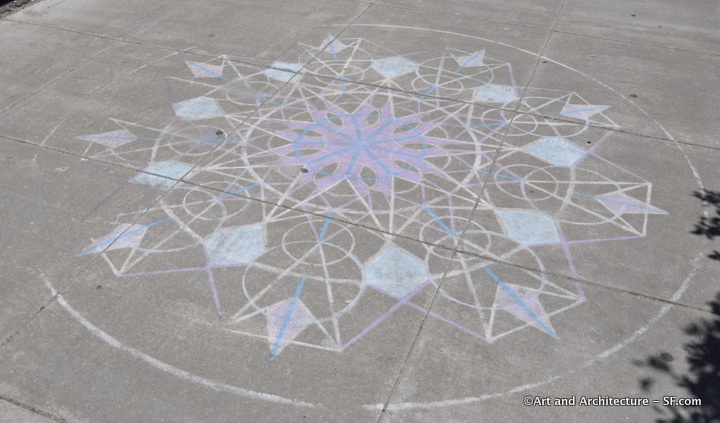 Hayes Valley came to prominence when film director Erich von Stroheim chose the corner of Hayes and Laguna for the filming of his 1924 film “Greed.” His affections were for a 19th-century Victorian that had been built in the early 1880s by Col. Michael Hayes as an amusement pavilion, though word has it Hayes constructed the building to lure an extension of the streetcar line to Hayes Valley. The building survived the 1906 earthquake and fire and at the time of filming was occupied only on the ground floor, by a French laundry and the Hayes Valley Pharmacy, which remained in business until the 1960s. Stroheim created signs for a dentist’s office and a photographer’s workplace for the movie, which fooled some locals into believing they were real. The film included numerous shots from the top floor of the building looking down on Hayes Valley. He also used 595-597 Hayes, a building that acted as a storeroom in the 1920s, as the site of the saloon in the film.
Hayes Valley came to prominence when film director Erich von Stroheim chose the corner of Hayes and Laguna for the filming of his 1924 film “Greed.” His affections were for a 19th-century Victorian that had been built in the early 1880s by Col. Michael Hayes as an amusement pavilion, though word has it Hayes constructed the building to lure an extension of the streetcar line to Hayes Valley. The building survived the 1906 earthquake and fire and at the time of filming was occupied only on the ground floor, by a French laundry and the Hayes Valley Pharmacy, which remained in business until the 1960s. Stroheim created signs for a dentist’s office and a photographer’s workplace for the movie, which fooled some locals into believing they were real. The film included numerous shots from the top floor of the building looking down on Hayes Valley. He also used 595-597 Hayes, a building that acted as a storeroom in the 1920s, as the site of the saloon in the film.
In the 1950’s the Central Freeway was built over the top of the neighborhood and Hayes Valley quickly descended into a rough neighborhood that remained a spot for ladies and gentlemen of the night well into the 1990’s. The 1989 earthquake brought so much destruction to the Central Freeway that they tore it down. What evolved was a neighborhood, replete with wonderful individual (read non-chain) stores and lots and lots of excellent restaurants. Wikipedia even calls it a “fashionable” neighborhood.
In the heart of the area is Patricia’s Green (in memory of neighborhood activist Patricia Walkup), also called Hayes Green. It runs the length of Octavia, between Hayes and Fell.
The Green is the sight of ever rotating art installations. I ran into the little impromptu piece on the sidewalk of the Green.
It was tagged Nik Larsen 7/7/11. I took the photo on the 22nd of July. It is chalk, and I was amazed it still was in such good shape. It is titled Violet Eclipse Mechanics. What a wonderful ethereal piece of art, that proves you must always keep your eyes open.
Nik writes a blog Chalkvisions if you want to check out other things he has done around town.
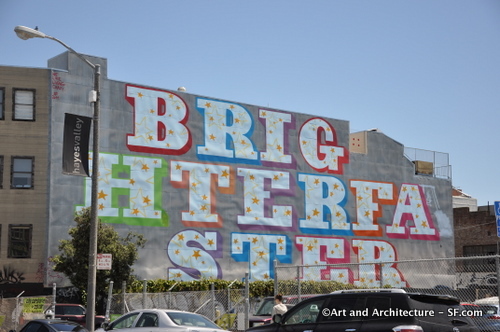 Just off the green is this piece by Ben Eine of London, a fun interview with him can be read here.
Just off the green is this piece by Ben Eine of London, a fun interview with him can be read here.I had the privilege of catching Andy Vogt in the process of making this piece. We chatted for awhile, as he worked putting lath into the chain link fence. This space surrounds a temporary landing spot for the Museum of Craft and Art. The museum is presently in a storage unit plunked down on the corner of Hayes and Octavia. The exhibit around the museum will run through October of 2011 and is entitled Place Making. The museum invited three artists and architects to design installations based on the sites impermanent condition with architectural themes consisting of proxy, transparency, layering and light.
Andy was the creator of the first of these installations. He is a San Francisco based artist with a BFA from Carnegie Mellon. His biggest constraint was putting sculptural elements into this space. Lath is typically no more than four feet long, but Andy was working with many pieces that were much shorter. Then he had the width and height of the chain link panels which was already installed before he began work. His work is really rather phenomenal, there is such an earthy quality to working with reclaimed lath, it has such wonderful different tones and age marks, making many personalities blend into one installation.
His website has photos of other installations he has done.
This installation is not longer available for viewing.
The Marble plaque on this wall reads:
Chinese Baptist Church
American Baptist Home
Mission Society of NY
Built 1888 Destroyed 1906
Rebuilt 1908
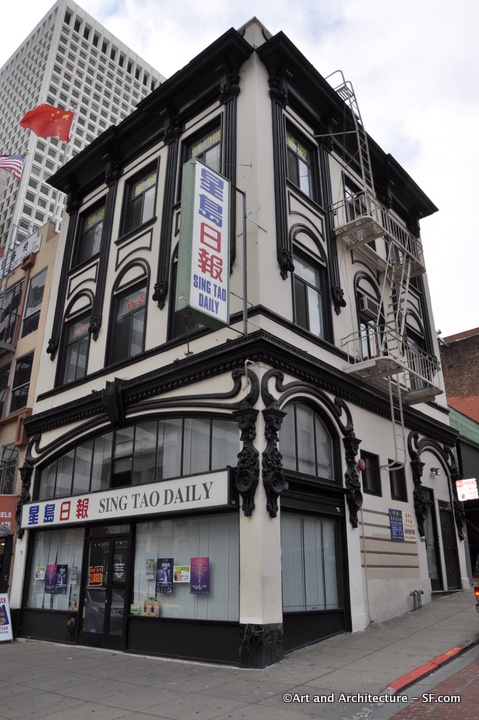 The first overseas office of the Sing Tao Daily was opened in San Francisco in 1975. The parent company of the Sing Tao Daily, the Sing Tao Newspaper Group Limited, was founded in 1938 and is based in Hong Kong. It has one of the longest publishing histories among the Chinese newspapers in Hong Kong.
The first overseas office of the Sing Tao Daily was opened in San Francisco in 1975. The parent company of the Sing Tao Daily, the Sing Tao Newspaper Group Limited, was founded in 1938 and is based in Hong Kong. It has one of the longest publishing histories among the Chinese newspapers in Hong Kong.
This amazing Art Nouveau building designed by Luigi Mastropasqua in 1907, is at the corner of Commercial and Kearny Streets in Chinatown. Mastropasqua is probably more famous for designing Julius’ Castle on San Francisco’s Telegraph Hill.
Commercial Street is one of the oldest thoroughfares in San Francisco, dating back to 1847. At that time Commercial Street was but two and a half short blocks—from Dupont (now Grant Avenue) to the old waterfront just past Montgomery (where Leidesdorff Street now is.) Its name derives from the fact that it was early San Francisco’s most prominent commercial street.
Commercial has a very colorful history, serving off and as a red light district of San Francisco in the Barbary Coast days.
This street also houses my favorite restaurant in Chinatown – City View Dim Sum Restaurant at 622 Commercial.
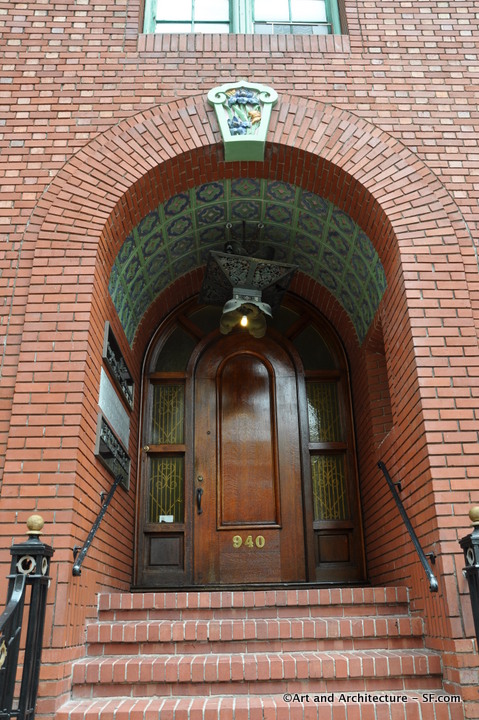 I love the architecture that you find in Chinatown. I actually think, more because of the history than the actual styles. This brick building with its’ beautiful tile arched entry is one of my favorites. It is the Gum Moon Womens Residence. It has a nice piece of marble with the inscription.
I love the architecture that you find in Chinatown. I actually think, more because of the history than the actual styles. This brick building with its’ beautiful tile arched entry is one of my favorites. It is the Gum Moon Womens Residence. It has a nice piece of marble with the inscription.
Chinatown is chock a block with murals, and this is one of my favorites. It is titled Dragons Gate and is by Wes Wong and Lost One. According to their website Fresh Paint they are “a San Francisco based mural painting company offering a fresh take on aerosol wall painting.” They are young, and their work shows that link from youth based tagging to professional mural execution”
You can find Dragon’s Gate on the corner of Trenton and Pacific Avenue.
This mural was sponsored in part by SFAC StreetSmArts Program.
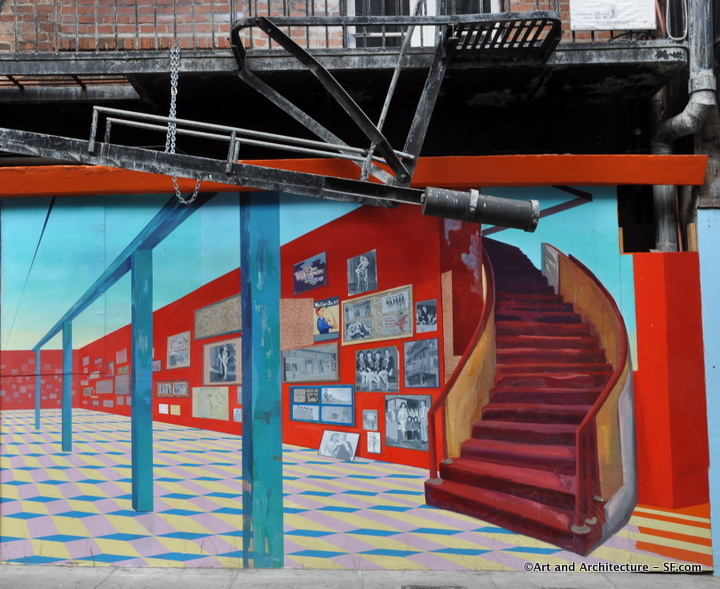 Wentworth Street between Jackson and Washington presently holds these two murals. The first is here thanks to the Art in Store Fronts Project (a San Francisco Arts Commission Program) and is painted by Robert Minervini. Robert received his MFA from the San Francisco Arts Institute in 2009 and lives in San Francisco. His works can be seen on his own website. This mural is entitled “If these Walls Could Talk” and was done in collaboration with Adopt-An-Alleyway youth volunteers. It is a montage of images generated by interviews with local residents and the history of Wentworth Street.
Wentworth Street between Jackson and Washington presently holds these two murals. The first is here thanks to the Art in Store Fronts Project (a San Francisco Arts Commission Program) and is painted by Robert Minervini. Robert received his MFA from the San Francisco Arts Institute in 2009 and lives in San Francisco. His works can be seen on his own website. This mural is entitled “If these Walls Could Talk” and was done in collaboration with Adopt-An-Alleyway youth volunteers. It is a montage of images generated by interviews with local residents and the history of Wentworth Street.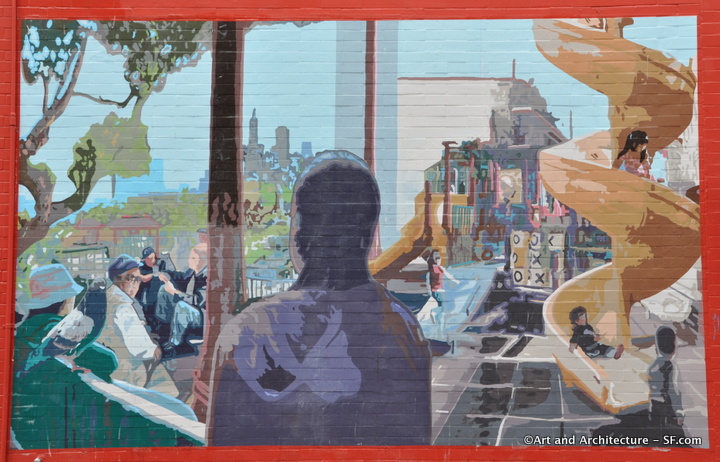 This is also on Wentworth alley, painted by Adopt-An-Alleyway youths. It is a depiction of the “living room of Chinatown” Portsmouth Square.
This is also on Wentworth alley, painted by Adopt-An-Alleyway youths. It is a depiction of the “living room of Chinatown” Portsmouth Square.The mission of the Adopt-An-Alleyway (AAA) Youth Project is to have high school students monitor and organize clean-ups to beautify Chinatown’s forty-one (41) alleyways, provide services to the Chinatown community, and to help these youth develop leadership skills.
They also run an Chinatown Alleyway’s Tour.
Chinatown has three times more alleys than streets and they all are worth exploring. The locals have done an amazing job in cleaning up the alleys and giving tourists a reason to go down them, with markers, history walks and little finds like this. By the way, Wentworth Street is nicknamed Salty Fish Alley because of the many dried seafood stores that filled it in the early 1900’s.
743 Washington Street
Chinatown
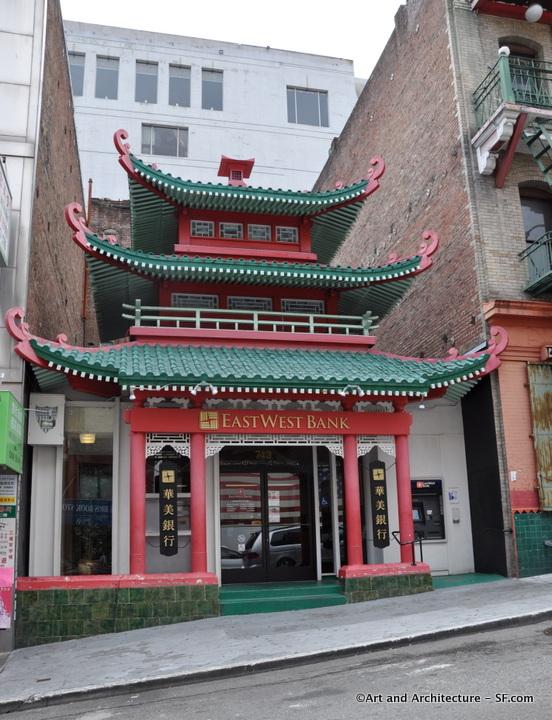
San Francisco’s Chinatown is the oldest Chinatown in North America and the largest Chinese community outside Asia. Established in the 1840s, It plays an extremely important part in the history of San Francisco and the history of the Chinese diaspora. Chinatown is the most densely populated neighborhood in the city and one of the most densely populated neighborhoods in the United States. It is also one of the more working class neighborhoods of San Francisco. Chinatown has more visitors annually than the Golden Gate Bridge.
The Chinese Telephone Exchange sits at 793 Washington. In 1891, the first public telephone pay station was installed in Chinatown. In 1894, a small switchboard was set up to serve the patrons of the phone system. People were often asked for by name rather than by number, so telephone operators had to memorize and know each patron by name. This made telephone numbers unnecessary, which was important since the Chinatown community felt it was rude to refer to people by numbers. Operators also knew the address and occupations of patrons so they could distinguish between two people with the same name. In addition, they had to speak five Chinese dialects as well as English.
Technology changed, and switchboards were no longer needed. The Bank of Canton bought and restored the building in 1960.
Chinatown has an incredibly rich history and there are hundreds of books out there about it, but two that I find especially interesting are: “The Barbary Plague” by Marilyn Chase and “Genthe’s Photographs of San Francisco’s Old Chinatown” by Arnold Genthe and John Kuo Wei Tchen.
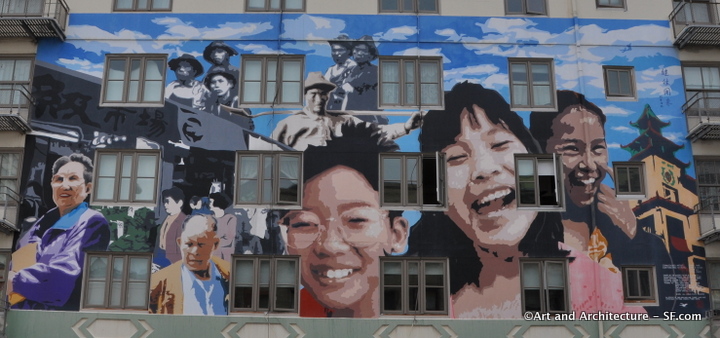 This mural is also on the Ping Yuen Housing Project. This is the Stockton Street Side of the building.
This mural is also on the Ping Yuen Housing Project. This is the Stockton Street Side of the building.
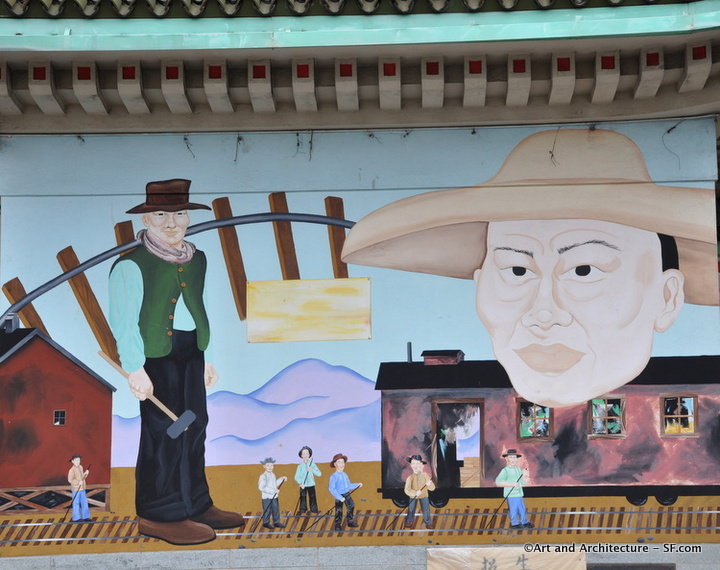 Walking further down Stockton Street towards the tunnel you will find this mural on the Victory Memorial Hall it was erected by the China War Relief Association of America and painted by Amy Nelder.
Walking further down Stockton Street towards the tunnel you will find this mural on the Victory Memorial Hall it was erected by the China War Relief Association of America and painted by Amy Nelder.According to Wendy’s website she “comes from a rich San Francisco tradition. Her grandfather, Al Nelder, was the revered former Chief of Police for San Francisco and her mother, Wendy, is the former president of the San Francisco Board of Supervisors. She continues that spirit of public service by being one of only 18 fulltime forensic artists in the United States as the forensic artist for the San Francisco Police Department.”
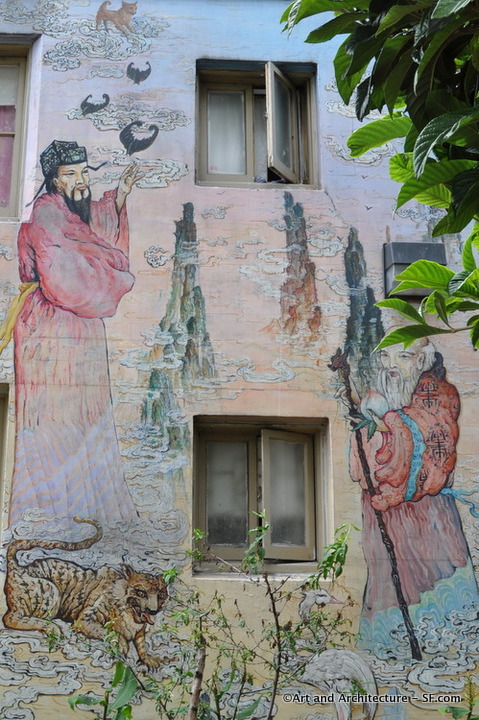 I was stopped short by this set of murals. The style is so obviously asian and yet you just don’t see that style outside of the asian world when it comes to murals. This is the front of the Ping Yuen Public Housing Project on the corner of Stockton and Pacific in San Francisco. The housing project was built in 1952, and designed by Architect Henry Temple Howard. Howard was a graduate of UC Berkeley and the Ecole de Beaux Arts. After a stint with his father, architect John Glen Howard, he went to work for Blakewell and Brown, the architects of Coit Tower. He worked with landscape architect Mark Daniels on this project.
I was stopped short by this set of murals. The style is so obviously asian and yet you just don’t see that style outside of the asian world when it comes to murals. This is the front of the Ping Yuen Public Housing Project on the corner of Stockton and Pacific in San Francisco. The housing project was built in 1952, and designed by Architect Henry Temple Howard. Howard was a graduate of UC Berkeley and the Ecole de Beaux Arts. After a stint with his father, architect John Glen Howard, he went to work for Blakewell and Brown, the architects of Coit Tower. He worked with landscape architect Mark Daniels on this project.Ping Yuen has three buildings, east, middle and west. There are playgrounds in the back and small landscaped areas for sitting. Despite being surrounded by high fences and lots of bars on the windows most people that live there consider it a very safe place to live.
 This sculpture is located at the corner of Bayshore Blvd, Cesar Chavez and 26th Street, just to the side of Highway 101. Though it was installed in 2004, to mark the beginning of a new bike path, they just started construction on said path this month.
This sculpture is located at the corner of Bayshore Blvd, Cesar Chavez and 26th Street, just to the side of Highway 101. Though it was installed in 2004, to mark the beginning of a new bike path, they just started construction on said path this month.
The sculptor, Pepe Ozan, stated that the piece represents an Eagle-Warrior, an institution that survived all of Mesoamerica’s civilizations throughout 2000 years until the arrival of the Conquistadors. The Eagle-Warriors were a corps of elite who served as leaders in religious ceremonies as well as on the battlefield.
The plaque on this sculpture reads “Presented to Honor the Indigenous Heritage of This Region”
The piece was part of the SFAC 2006-07 budget and cost $14,000.
Pepe Ozan (1940-2013) was an Argentinian sculptor that was very active with Burning Man.
From the Burning Man Blog:
One of Pepe’s lingam sculptures was first burned at Burning Man in 1993, and he created “Pepe’s Tower” each year after that until 2000. In Burning Man’s early years in the Black Rock Desert, the ritual burning of “Pepe’s Tower” on Friday night was traditionally followed by the burning of the Man the next evening. The Friday night ritual became more elaborate each year, and in 1996 it was renamed “The Burning Man Opera”.
“Le Nystere de Papa Loko” opera, 1999 (Photo by Tom Pendergast)
Pepe’s elaborate operas included “The Arrival of Empress Zoe” (1996), “The Daughters of Ishtar” (1997), “The Temple of Rudra” (1998), “Le Mystere De Papa Loko” (1999), “The Thaur-Taurs of Atlan” (2000), and “Ark of the Nereids” (2002), which featured a 35′-long mobile sculpture / musical instrument in the form of a Spanish Galleon crossed with a mythical aquatic creature. These epic performances, remembered fondly by so many in our community, would feature over 2,000 dancers and performers – in a true demonstration of radical inclusion, any and all Burners were invited to participate.
My office is only 5 blocks from this spot, and I drive by this spot at least 3 times a week. I am not sure if I really have never seen it, or, more likely, the city finally got around to clearing away overgrown trees and shrubs.
I bring this up, not to point out my intense concentration on the road while I drive, but to discuss a problem that the City of San Francisco has with its art collection It has been said that the cities collection is valued at around $90 million dollars and includes over 4,000 items, one of the richest city-owned art collections in the world.
Sadly, management of the collection is so shoddy that the city cannot say for sure how many pieces it owns. Some pieces have been damaged because of lack of maintenance or poor storage; others have disappeared entirely.
The San Francisco Arts Commission is the city agency responsible for the collection. The page of their website that listed the collection shut down recently, with an apology that they were trying to get a better handle on the collection and bring a more complete list to the public.
Since the Civic Arts Collection’s inception in 1932, a full survey of the city’s holdings has never been done. A complete inventory is under way, but until its scheduled completion in late 2012, the city can only guess at the collection’s size.
Approximately 900 pieces are in storage, while the rest are scattered around parks, hospitals, offices, courtrooms and other public city-owned spaces.
The budget to tally, repair and keep an eye on the collection is minimal, and the staff almost non-existent.
What I suspect here is that this particular sculpture was hidden in the local flora, only to be discovered again after the gardeners arrived.
 This mural is on the corner of 10th Street and Sheridan in the South of Market Area of San Francisco. The artist is Meagan Spendlove. Her website reads “Meagan Spendlove currently works in San Francisco, California as a professional designer, illustrator and project coordinator. Her latest endeavors include yet are not limited to mural project coordination and digital illustration. Over the past twelve years her style has become recognized mainly for its feminine subject matter and organic ingredients. Assorted shaded ethereal women & bright colors surrounded by bold lines, similar to stained glass.”
This mural is on the corner of 10th Street and Sheridan in the South of Market Area of San Francisco. The artist is Meagan Spendlove. Her website reads “Meagan Spendlove currently works in San Francisco, California as a professional designer, illustrator and project coordinator. Her latest endeavors include yet are not limited to mural project coordination and digital illustration. Over the past twelve years her style has become recognized mainly for its feminine subject matter and organic ingredients. Assorted shaded ethereal women & bright colors surrounded by bold lines, similar to stained glass.”
The bright colors are what caught my eye, otherwise, it is on a very obscure alley and very easy to miss.
This is the center section of the Alcazar, it is flanked by two matching wings.
In 1976, the Alcazar was awarded the highest rating for architectural significance in a survey of city buildings. Located at 650 Geary Street, between Jones and Leavenworth in the Tenderloin, it was built in 1917 at a cost of $150,000 as the Islam Temple, Ancient Arabic Order Nobles of the Mystic Shrine. The Shriners, a men’s social and charitable organization of the Freemasons, used the building until 1970. The building was designed by Scottish-born architect Thomas Patterson Ross. The Landmarks Preservation Advisory Board referred to its style as Moorish Byzantine Eclectic, a style inspired by Oriental and Persian architecture. Some sources indicated that Ross, also a Shriner, was inspired by the Moorish palace of the Alhambra in Granada, Spain.
The Shriners’ continued to use the building for meetings and other lodge functions until 1970, when it became the 511-seat Alcazar Theater. The name recalls an historic theater on O’Farrell Street that burned in 1906. A new Alcazar had been built on that site, but was demolished in 1963 to create a parking lot. The Alcazar Theater closed in 1984 but reopened in 1992 after undergoing a controversial rehabilitation. The garage was not a later addition but part of the original design. The Shriners often included commercial space in their buildings to help pay for the building and their other charitable projects.
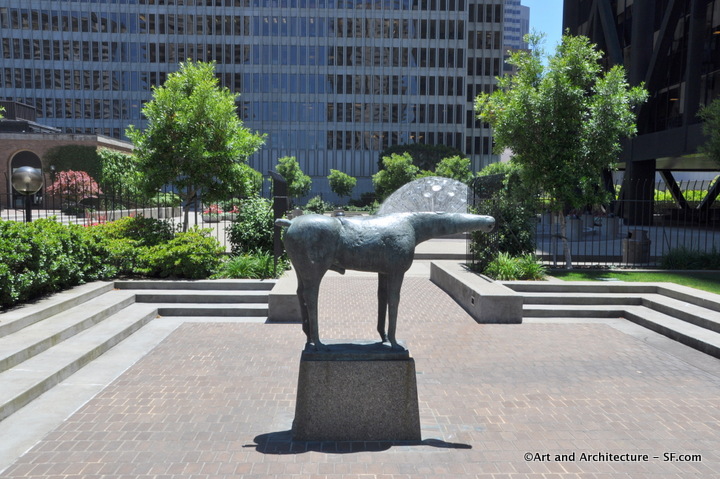 Bronze Horse” by Marino Marini. The fountain behind it is by Robert Woodward.
Bronze Horse” by Marino Marini. The fountain behind it is by Robert Woodward.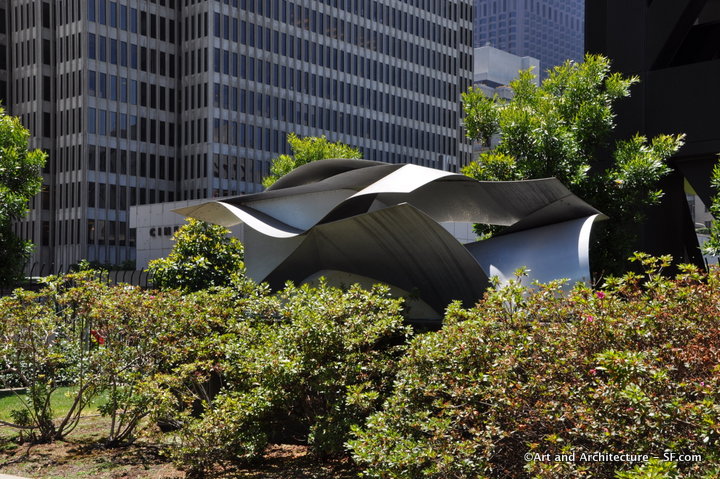 This is “Limits of Horizon” by Jan Peter Stern. I love how the plants have grown to soften this piece. In the photo it is lost to the surrounding buildings, and even in situ it is very ethereal.
This is “Limits of Horizon” by Jan Peter Stern. I love how the plants have grown to soften this piece. In the photo it is lost to the surrounding buildings, and even in situ it is very ethereal.Kevin Leeper is a San Francisco Art Institute graduate and part time teacher at Diablo Valley College. He designed and fabricated the gate in 1993 in response to the local residents wish to have a more secure area at night. What this door opens onto is “The Tenderloin National Forest”. In 1989 a group of artists formed the nonprofit Luggage Store Gallery. The artists annexed the 25 by 136 foot alley and began slowly transforming it. The idea to build a forest was sparked when the group covered the area with rolls of sod as part of one of its many public events. The forest consists of cherry, cypress and Japanese maple trees plus a pair of redwoods, the tallest of which is four stories high. Edible plants and herbs grow in raised boxes, and aloe, cactus, ginkgo and ferns are scattered throughout.
This mural is on a building at the corner of 7th and Folsom Streets, (It is on the 7th Street side) in the South of Market area of San Francisco.
It was done by 1:AM short for First Amendment, a gallery at 1000 Howard Street in San Francisco.
According to 1:AM they are “a gallery that stands behind the freedom of speech. We strive to showcase, teach, and inspire the public on street and urban art through our exhibitions, education, and street productions… With the gallery, classes, and a veteran mural production team, 1:AM has become a pillar in San Francisco street art culture. ”
I contacted 1:AM to see what the mural was all about and this is what one of the artists told me:
“My name is Robert and I’m one of the artist involved with the mural. We really appreciate the communities interest and curiosity about the mural. We painted this mural more for the public in that area, seeing as how that particular wall is often plagued with graffiti. The theme of the murals we usually paint have to do with the community and the surrounding area. For example, this mural is down the street from court and gets a lot of foot traffic from people either going or coming from court. It’s intended to be a positive and uplifting work of art, for people who usually would be stressed out from either work or just having a bad day, thus the vibrant and exciting colors used along with the playful phrase, ‘cus after all “That’s Califor’ya!” ”
UPDATE 4/2013 There was a slight mishap with a mistaken painting over of this mural. It is back with a few minor changes – here is the new view.
*